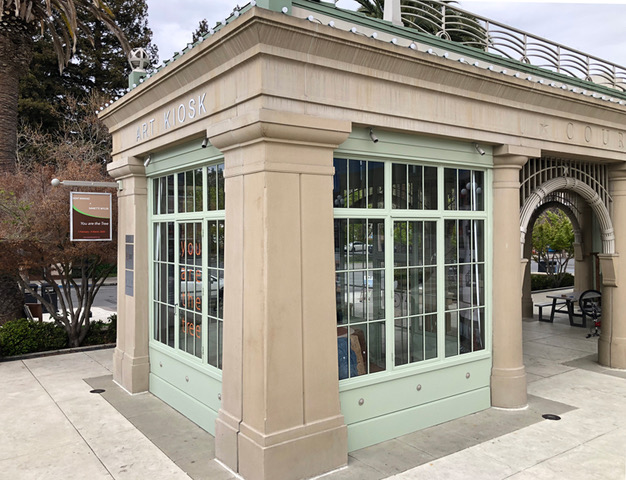
A sculptural installation by Kent Manske & Nanette Wylde
You are the Tree is a seven foot diameter replica of an old growth, coast redwood tree stump. Coast redwoods are considered the largest trees on earth with heights nearing 400 feet, diameters upwards of 30 feet, and lifespans close to 2000 years. Coast redwoods only grow in the Coast Range, a 400 mile strip on the Western edge of California, and are currently classified as endangered.
This project was initially commissioned by Fung Collaborative Projects for the Redwood City Art Kiosk located in downtown Redwood City, California. Manske and Wylde focused on local California history as a means to develop the conceptual framework for this project. Redwood City is significant in the history of California because of its proximity to a variety of exploitable natural resources, and because of its natural geographical features--it originally had a sizable navigable creek, Redwood Creek, and it is the only deepwater South Bay port. The rapid development of this region is based on natural resource extraction industries. These began with the Gold Rush era, the U.S. acquisition of California as a territory in 1848, and the resultant mass migrations of Americans and Europeans to this region.
Redwood City was incorporated in 1867 with a population of laborers and local businesses serving extraction industries including those harvesting trees, mercury, salt, various rocks and minerals, and oysters. Today Redwood City is a vibrant, San Francisco Bay Area community with an active labor force serving Silicon Valley's data, biotech and venture capital industries.
Upon approach of You are the Tree one sees a seven foot diameter replica of an old growth, coast redwood tree stump. The stump's multi-colored and highly textured bark alludes to the beauty and value of human and environmental diversity. Concentric growth rings are visible on the surface of the stump. Small flags mark significant disruptive innovation events which occurred during the last 400 years, the lifespan of the tree. A thin slice of green rests on the stump's surface, representing the 5% of coast redwoods saved from the 19th century extraction/clear cutting of redwoods from the Coast Range.
This handcrafted paper pulp sculpture was made from locally sourced, Redwood City, craft industry byproducts such as spent beer grains, eggshells, fabric scraps, flower parts and hair. The 25 unique bark sections are tagged with legacy tree markers to identify both contributors and byproduct materials. Each section celebrates local labor and honors people who make things with their hands. It calls attention to issues of sustainability including byproduct reuse.
You Are The Tree asks us to consider:
What are we willing to put at risk for future generations to have something ourselves today?
What role can and do individuals play in environmental health and a sustainable culture?
What can I do to participate positively in creating a sustainable, healthy city?
What is my byproduct and what can I do with it creatively without causing harm?
Exhibitions
Redwood City Art Kiosk, Redwood City, California
February 1–March 22, 2020
Art Ark Gallery, San Jose, California
March 4–April 1, 2022
Art Works Downtown, San Rafael, California
February 3–March 25, 2023

You Are The Tree is Available for Exhibition
The presentation of You Are The Tree can be adapted to address environmental, labor and sustainability issues specific to exhibition communities. The inclusion of a live coast redwood is an optional component for future installations. Manske and Wylde are supportive of programming which serves exhibition venue's public facing missions, such as demonstrations, workshops and sustainability interventions.
Contact the artists at kent.manske at preneo.org.

Art Kiosk, Redwood City, California
February 1 - March 22, 2020
You Are The Tree was presented in Redwood City as a site specific installation in early 2020. This installation included a living coast redwood sapling emerging from the stump. Photographic slices of Redwood City's new, residential high-rise buildings tower in each of the glass kiosk's four corners. Through the windows landmark buildings, including the Fox Theatre and the former San Mateo County Courthouse, are visible. The kiosk windows contain four words: you are the tree.
This installation including scheduled public interaction hours; a touching station which allowed kiosks visitors to handling samples of the pulped byproducts which make the tree's bark; and a small run publication on the project which you may download below.
Guide to You are the Tree for download.
Press:
The Daily Journal
Palo Alto Weekly
Extraction: Art on the Edge of the Abyss
Community Partners
Manske and Wylde collected industry byproducts from over 30 local small business entities, turned it into pulp, made thick paper sheets, then sculpted the wet sheets on to a wire frame structure. These bark sections are tagged with numbered legacy tree markers which identify both contributors and byproduct materials.
The contributors include: Alana's Cafe, Alloy Cutting, Broadway Cleaners, Connoisseur Coffee Company, The Daily Journal, Dobson Beekeepers, Donato Enoteca Restaurant, Dragon Theatre, Freewheel Brewing Company, Fuse Theatre, Gents Barber Parlor, Ghostwood Brewing Company, Golden Bay Glass, La Honda Winery, Main & Elm Restaurant, Milagros Latin Kitchen, Old Port Lobster Shack, Radhika Beauty Salon, Raul's Grooming Center, Redwood City Florist, Sager Family Farms, Sigona's Farmers Market, Torres Custom Upholstery, and University Art Supply. Hold Fast Tattoo, Poseidon Pools, Redwood City Ace Hardware, and Woodside Bike Shop contributed infrastructure materials. Wegman's Nursery donated the living coast redwood tree which will be planted in Redwood City's Red Morton Park at the end of the Art Kiosk exhibition. Research assistance was provided by the Local History Archive Room, Redwood City Public Library; and the San Mateo County History Museum. The book Redwood City, A Hometown History by the Archives Committee of the Redwood City Public Library provided valuable contextual and historical documentation. Photographer David Beres photographed the residential towers specifically for this project.

A legacy tree marker guide was available to kiosk visitors.
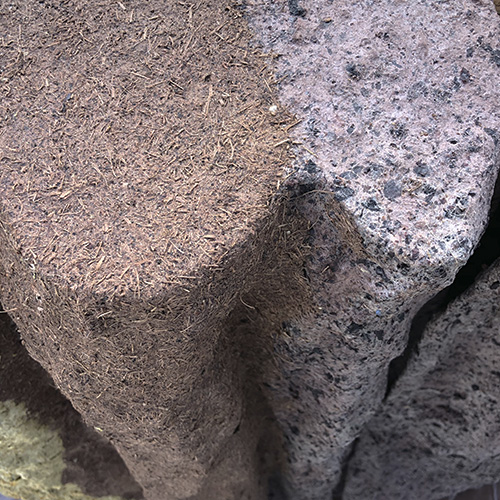
grape stems: La Honda Winery
grape skins: La Honda Winery

blue jeans, metal shavings: Local Laborers, Alloy
Cutting
hops: Freewheel Brewing Company
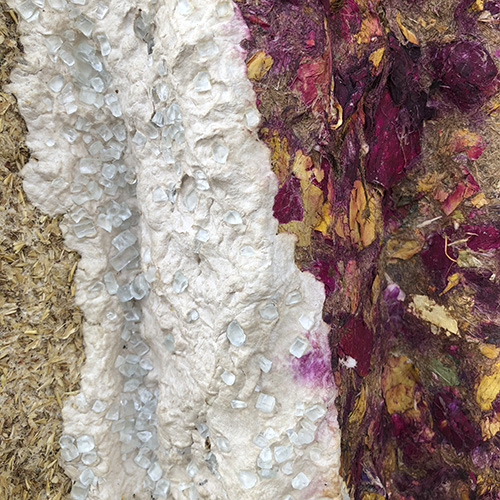
glass, unprinted newsprint: Golden Bay Glass, The Daily
Journal
flowers, bees wax: Redwood City Florist,
Mike & Tina Dobson Beekeepers, Sager Family Farms

toasted barley: Ghostwood Brewing Company
barley: Ghostwood Brewing Company
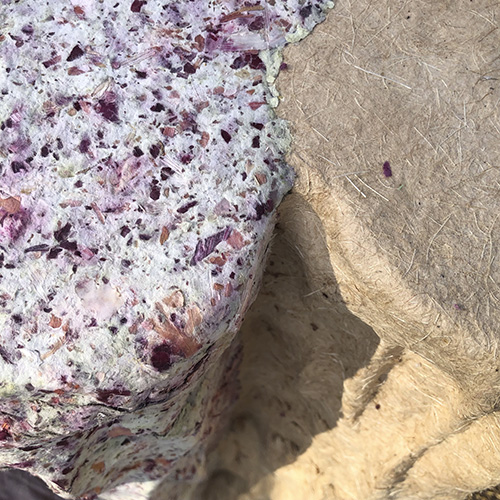
onion skins: Donato Enoteca Restaurant
burlap shipping sacks: Connoisseur Coffee Company

egg shells: Alana's Cafe
classroom kraft
paper table covers, pencil shavings, rag paper scraps:
University Art Supply, Local artists
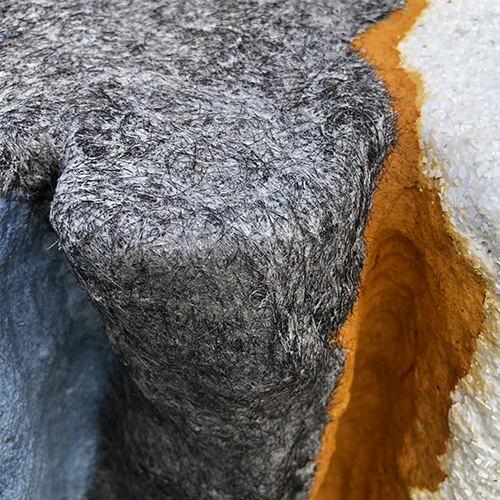
hair, recycled newspaper: Gents Barber Parlor,
Radhika Beauty Salon, The Daily Journal
turmeric
spice: Neighborhood Chefs
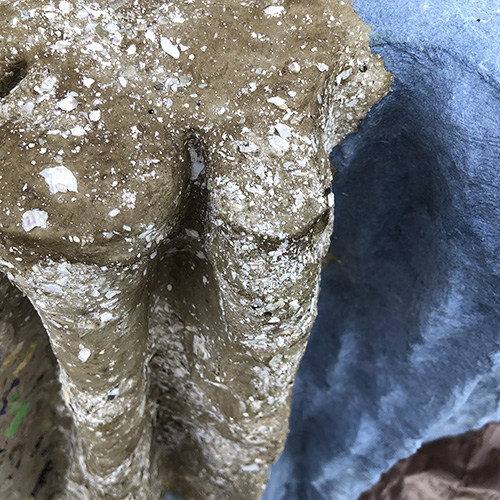
oyster shells, Redwood Creek water and sediment: Old
Port Lobster Shack, Redwood Creek
blue jeans:
Local Laborers

cardboard stage props, fabric scraps: Dragon Theatre, Fuse Theatre
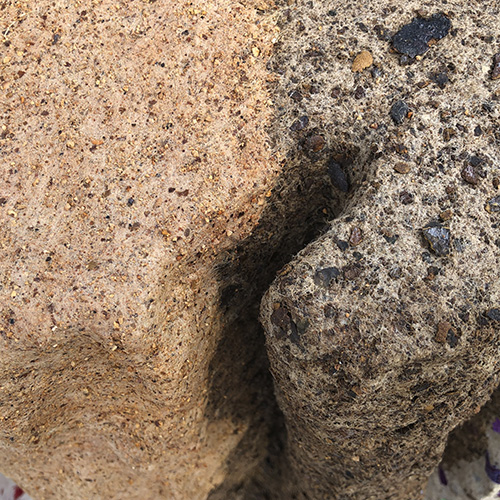
avocado seeds: Milagros Latin Kitchen
avocado skins: Milagros Latin Kitchen
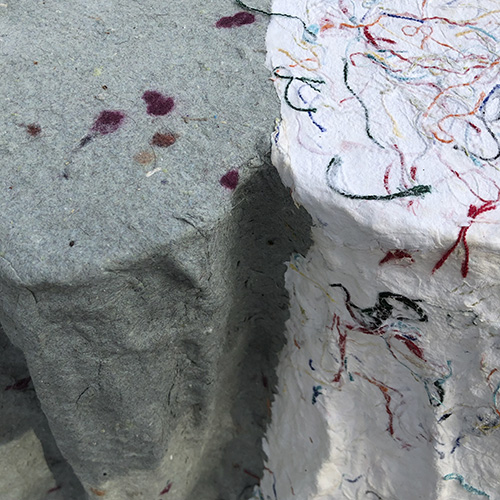
dryer lint: Broadway Cleaners
upholstery threads, cotton rags: Torres Custom
Upholstery, Local Artists
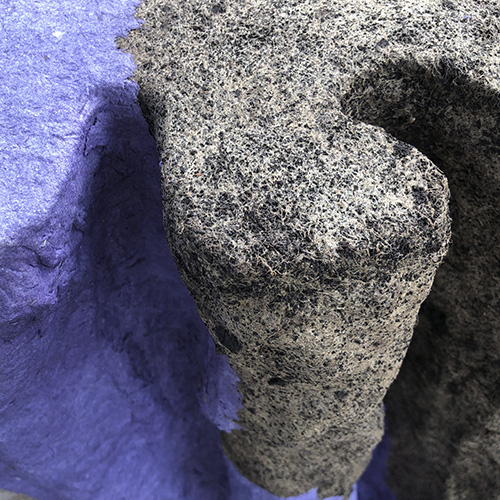
fruit packing trays: Sigona's Farmers Market
coffee grounds: Main & Elm Restaurant
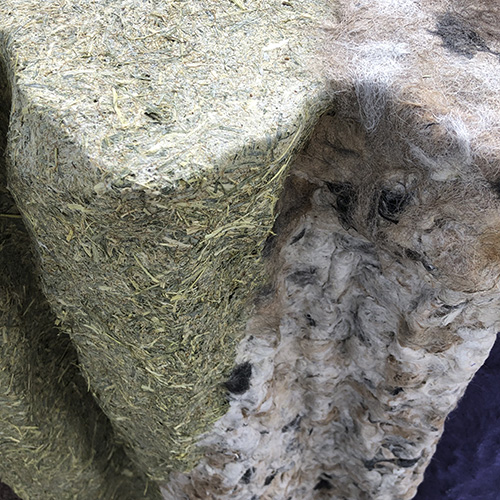
corn husks: Sigona's Farmers Market
pet
fur: Raul's Grooming Center
Artists' Statement and Historical Context
We live in a time of hindsight and nostalgia. The advancement of digital technologies and the way they have allowed us to see into and connect with the lives of others on a global scale, have something to do with this. Digital technologies have also changed the way we work. Humans are makers—our cultural and evolutionary histories are based, in large part, on our physical labor and inventions. Today, many of us work in offices in front of computer screens. Today, many of the challenges of survival—which previously involved being out-of-doors navigating wild places—have been replaced with monetary and data systems which require navigating people in offices and structures of compliance.
When California was being colonized by the Europeans and European Americans, the prized resources extracted from her soils were, of course, gold, and also the seemingly abundant, excessively majestic, redwood tree. These are the two primary resource extraction industries that resulted in the development of Redwood City. Neither was sustainable. Although it brought new populations to California, the Gold Rush was relatively short lived at seven years. The 19th century extraction of the Coastal Redwoods resulted in the removal of 95% of these old growth trees in less than 50 years. Globally, old growth trees of all species are still at risk, but now more for the land they occupy than the lumber they provide. Today the prized resources extracted from our planet are hydrocarbons in the form of crude oil and gas. These run the global economy, and the rights of control over them is the stuff wars are made of.
Here, in 2020, we are able to see many of the effects of our past practices, and many of these are not positive in terms of human and planetary health. Our cities, and even our countrysides, are built from materials extracted from our earth. These built environments were not designed as self-sustaining systems, but rather lack stability, depend on continuous maintenance and are ever hungry consumers of energy creating resources. Our habitual natures and societally created beliefs encourage us to continue in lifestyles that we know are unhealthy for us, individually as well as collectively, and are unsustainable as we continue to deplete earth's resources. Invented needs and media induced presumptions allow us to believe in our own absence of determinacy, and rights of privilege over the natural world. Our consumer demands discourage conservation.
Simultaneously, we are experiencing a resurgence of interest in and desire for slower lifestyles that involve the mark of the handmade. We are becoming aware of our psychological need as humans to be in wild places and away from our devices and plastic appliances. There are many things that feel empty or are just not as good when carried out by a robot, computer program or artificial intelligence product than they are when made with human hands. We are drawn to nature as well as to the handcrafted, creative products of our fellow humans.
Redwood City is significant in the history of California because of its proximity to a variety of exploitable natural resources, and because of its natural geographical features—it originally had a sizable navigable creek, Redwood Creek, and it is the only deepwater South Bay port. The rapid development of this region is based on natural resource extraction industries. It is these that prompted California statehood in 1850, and mass migrations to California which began during the California Gold Rush. People were looking for new ways to "make a living" and improved lifestyles. Speculators and investors were looking for wealth.
There were five natural resource extraction industries which influenced and prompted the development of Redwood City. The first was the California Gold Rush which began in 1848 and ended by 1855. In 1848 California's population was considered to be roughly 160,000 people, most of whom were Native Americans. At that time, California had just been ceded to the United States as a result of the Mexican-American War. [1] The Gold Rush brought an additional 300,000 people, mostly European Americans, but also people from other lands. These immigrants perceived California's natural resources as opportunities available to be taken.
The clear cutting of the Coast Redwoods [2] began in the 1850s. The Santa Cruz Mountains which extend south of San Francisco to Monterey Bay, were logged first from the east side. The logs were dragged by oxen down to Redwood Creek and then floated up to San Francisco via tidal action for use and export out to the world. This resulted in the development of the Port of Redwood City.[3] Once the forests on the east side were cleared, logging began on the west side. The majority of these trees were hauled up to the summit and then back down to the Port of Redwood City as this was easier than moving them up the coast to San Francisco via the ocean. Every old growth tree in the Santa Cruz Mountains would likely have been harvested if not for a group of concerned citizens who founded the Sempervirens Fund in 1899. [4] Most of the Coast Redwoods that we see today are between 50 to 150 years old. The old growth redwoods logged in the 19th century were upwards of 2,000 years old.
Poison residue from mercury mining continues to be a critical Gold Rush effect in terms of human and animal health in the San Francisco Bay region.[5] Mercury was used in gold mining to separate the gold from sediment and rock. California was rich in cinnabar, a common mercury mineral easily identified by its red color. This discovery resulted in thousands of mercury mines. Many were located in the Coast Range. [6] Mercury enters the Bay from tributaries near the mining source as well as being carried down from gold mining sites in the Sierras. The single most significant source of mercury in the San Francisco Bay is the New Almaden Quicksilver mine, located near the Guadalupe River in the Almaden Valley, now a part of South San José. When mercury enters water systems bacteria transform it into a highly poisonous neurotoxin, methylmercury, which is absorbed by plant life and subsequently moves all the way up the food chain to human and animal consumers of Bay Area seafood. Mercury continues to enter the Bay from various watersheds, including the Guadalupe River. There are attempts to limit mercury run off and clean up the Bay, but legacy amounts (meaning that which entered the Bay during the Gold Rush) of methylmercury which remain on the Bay floor are continuing to erode and are impossible to clean up. [7]
For thousands of years prior to the Gold Rush era the San Francisco Bay was rich with oysters, which were a food source for the Ohlone and Coastal Miwok people. Evidence of this were the existence of massive shell mounds throughout the Bay Area.[8] These ancient oyster beds produced a relatively small oyster which the new inhabitants of the Peninsula thought to be inferior in taste to oysters from the East Coast. Thus attempts were made to reseed the Bay's oyster beds with East Coast varieties. As Bay Area cities developed and the area industrialized, pollution, including raw sewage and massive amounts of sediment from hydraulic mining in the Sierras, resulted in oyster industry failure. In 1923 South Bay Morgan Oyster of Redwood City sold their holdings to Pacific Portland Cement (now CEMEX). Pacific Portland Cement began dredging the bay to remove the oyster beds, some 30 feet deep, to make cement. [9] The decimation of the oyster population and loss of reefs significantly affected local wildlife habitats and ecosystems. Currently, the California Coastal Conservancy with the San Francisco Bay Living Shorelines Project are working to bring back the nearly extinct Olympia oyster and restore its long-lost reef habitat in the San Francisco Bay. This is important as oysters are exceptionally effective water filters, when not overwhelmed by excessive pollution. [10]
Salt extraction is another industry with a long history in the Redwood City area. [11] Significant environmental issues resulting from salt extraction have to do with the creation of salt ponds—the walling up of marshlands [12] via built levees to prevent bay water in the form of tides from flowing in and out. This resulted in damage to tidal marsh ecosystems and bay wildlife. It is estimated that 95% of the original tidal salt marshes were lost by 1990.[13] Salt extraction is responsible for most of this loss. Tidal marsh restoration is a recent effort towards repairing Bay Area ecosystems. [14]
Hydraulic mining is an example of a disruptive innovation which took place in California in the 1850s. This technology replaced pick and axe mining by using water cannons to wash gold and sediment out of the mountains and hillsides. It was responsible for significant scarring of the Sierras and fill-in of the San Francisco Bay and the Bay's waterways. Hydraulic mining in the mid 19th century required damming of small valleys in the Sierras for the purpose of creating a high pressure water flow. After pounding a targeted hillside, the water flowed down towards the ocean. The Sacramento and San Joaquin Rivers are part of this watershed. These rivers' ecosystems were damaged by gold mining runoff—mercury and silt—which filled in their beds and contributed to flooding in the Central Valley. Rock and silt from this 1850's practice continues to enter the Bay watershed. [15] The collective labor requirements of hydraulic mining also transformed independent gold miners into wage labor workers.
Conclusions
One of the complexities of our current
extraction-based culture is the relationship between issues of
sustainability and the real need for human occupation, i.e. employment.
Disruptive inventions such as artificial intelligence and robotic
technologies compounds this human labor component as machines
increasingly take on our previous physical occupations. We see this most
obviously in political discourse around jobs and employment as reasons to continue in
destructive and often outmoded extraction industry practices such as the
coal industry. At least, the employment language is targeted at the vulnerable
working class voter. It is likely not the real motivation to keep such
industries going. The real motivation is most probably corporate
profit.
So we have a dilemma. Humans need occupation—physically, mentally, and psychologically. We have evolved thus. But the culture we have created and currently exist in removes "meaningful" occupation from many of our lives. Consumption practices may be a substitute for meaningful occupation. However, most consumption practices do not address, let alone resolve, our shared global challenges. Rather they exacerbate many of our real, as well as perceived, problems. Sustainability of life on this planet, as we know it, among them.
Bibliography
Archives Committee of the Redwood City Public Library. Redwood City, A Hometown History. (Belmont, California: Star Publishing Company, 2007.)
Alpers , Charles and Michael P. Hunerlach, Jason T. May, and Roger L. Hothem. "Mercury Contamination from Historical Gold Mining in California." U.S. Geological Survey. PUBLICATIONS — Fact Sheet 2005-3014 Version 1.1. https://pubs.usgs.gov/fs/2005/3014/fs2005_3014_v1.1.pdf.
Barrett, Elinore M. "The California Oyster Industry" Calisphere. University of California. The Resources Agency of California, Department of Fish and Game. Fish Bulletin 123. 1963. http://content.cdlib.org/view?docId=kt629004n3;NAAN=13030&doc.view=frames&chunk.id=d0e411&toc.depth=1&toc.id=d0e411&brand=calisphere
Clarke, Chris. "San Francisco Bay's Lost World: The Salt Marsh." KCET. Redefine. June 30, 2015. https://www.kcet.org/redefine/san-francisco-bays-lost-world-the-saltmarsh.
Curry, Arwen. "Mercury in San Francisco Bay." Quest. KQED Science. November. 5, 2015. https://ww2.kqed.org/quest/2015/11/05/mercury-in-san-francisco-bay.
Fimrite, Peter "2 million oysters in bay begin restoration effort." SF Gate. Nov. 15, 2013. https://www.sfgate.com/science/ article/2-million-oysters-in-bay-begin-restoration-effort-4984300.php.
"Gold Mining and the Environment." Brilliant Earth. https://www.brilliantearth.com/gold-mining-environment/
"Gold Rush & Early History." History of San Francisco's Urban Planning. https://sfurbanplanning.weebly.com/early-history--gold-rush.html
Jenkins, Olaf P., Chief, California Division of Mines, San Francisco, California, December, 1951. "California Stone Industry (historical account up to circa 1950)." Stone Quarries and Beyond. http://quarriesandbeyond.org/states/ca/stone_industry/ca-stone_indust_upto1950_3.html.
Krotz, Dan. "Gold Rush Still Haunts San Francisco Bay." Science @ Berkeley Lab. November 29, 2005. https://www2.lbl.gov/Science-Articles/Archive/sabl/2005/November/01-gold-rush.html.
Mann, Lori. "The Aftermath of the Gold Rush: Mining and Mercury in the Bay." Saving the Bay, The Story of San Francisco Bay. KQED Education. http://education.savingthebay.org/wp-content/guides/The-Aftermath-of-the-Gold-Rush.pdf.
Meadows, Robin. "How Restoring Wetlands will Prepare Us for Sea Level Rise." Bay Area Monitor. February 2016. https://bayareamonitor.org/article/how-restoring-wetlands-will-prepare-us-for-sea-level-rise.
Norman, Steve. "Where the Redwoods Are." Coast Redwood Ecology and Management. https://redwood.forestthreats.org/range.htm
Sempervirens Fund staff. "Our History." https://sempervirens.org/about-us/our-history.
Sempervirens Fund staff. "Ten Amazing Facts About Redwoods." Hilltromper Santa Cruz. http://hilltromper.com/article/ten-amazing-facts-about-redwoods.
Romans, Brian. "San Francisco Bay Slowly Recovers From Gold Rush Miners' Devastating Legacy." Quest. KQED Science. Geology. November 18, 2010. https://ww2.kqed.org/quest/2010/11/18/gold-rush-sediment-in-the-san-francisco-bay.
Wohlleben, Peter. The Hidden Life of Trees: What They Feel, How They Communicate – Discoveries from a Secret World. (Vancouver, Canada: Greystone Books. 2016.)
Footnotes
[1]
The Spanish began colonizing California in the 1700's. It became a territory of
Mexico in 1822.
[2]
Sequoia Sempervirens are among
the oldest living things on this planet. They are also the tallest of
trees reaching upwards of 379 feet and 29 feet in diameter. Their normal
lifespan was between 1200 - 2000 years. They are currently considered
endangered.
[3]
Originally called The Embarcadero. Names in this region have changed many times over the
course of Western settlement.
[4]
The first protected grove was in Big Basin Redwoods State Park.
[5] Brilliant Earth.
[6]
Only 12 percent of the 220,000,000 pounds of mercury mined was used for gold recovery. The rest
was shipped out to Pacific Rim countries and western states. Alpers.
[7]
Mann.
[8]
Shellmound and Mound as place names continue in the Bay Area.
[9]
"Pacific Portland Cement Company's mill at Redwood City, which produces cement far in excess
of a million barrels annually, utilizes seashell accumulations from San Francisco Bay as
its sole source of lime." Jenkins.
[10] Barrett.
[11]
Various South Bay salt extraction industries ran from the current locations of
the San Mateo Bridge all the way to the Dumbarton Bridge.
[12]
Marshland, Salt marsh, Tidal marsh, Wetlands and Baylands are used interchangeably for this
ecosystem.
[13] Clarke.
[14] Meadows.
[15] Romans.
Making You are the Tree
Infrastructure
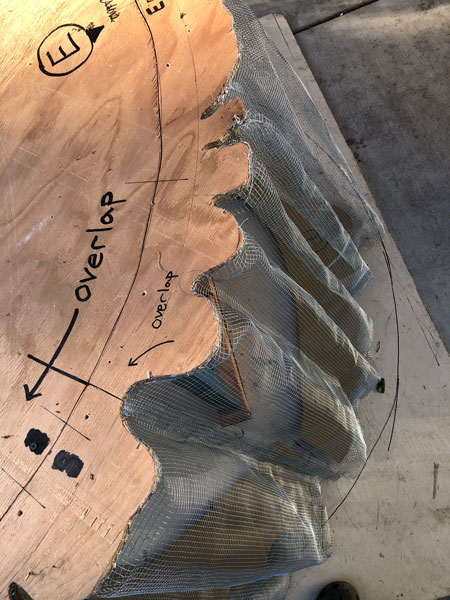
Structure made from hardware cloth.
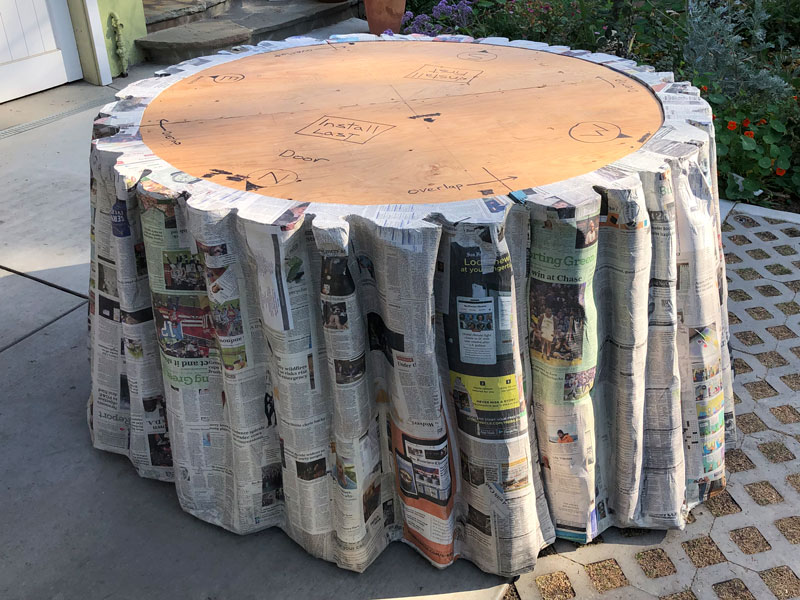
Paper-mâché applied to structure.
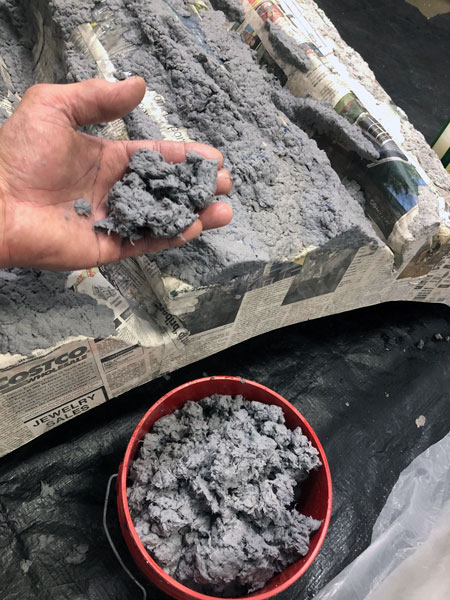
Adding bark texture with pulp.
Collecting Materials

Hops from Brewmaster Orion Lakota, Freewheel Brewing Company, Redwood City.
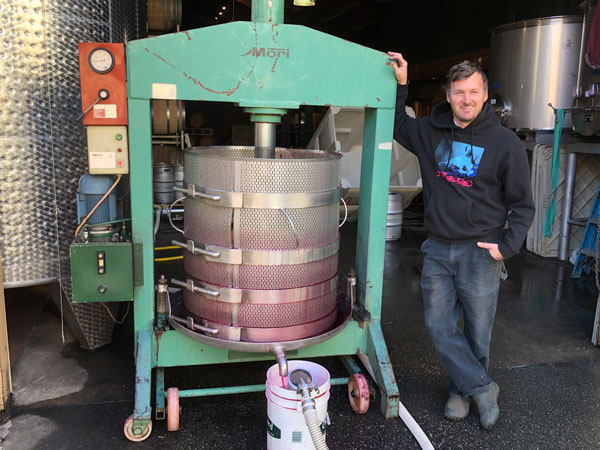
Grape skins and stems from Master of Wine Charlie Miller, La Honda Winery, Redwood City.
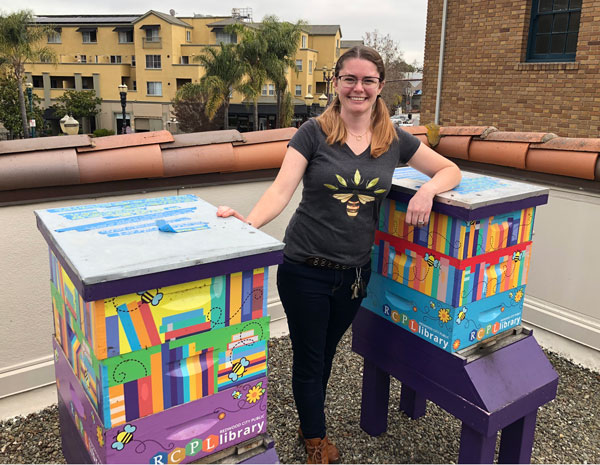
Beekeeper Kendal Sager of Sager Family Farms who provided beeswax from the Redwood City Main Library beehives.
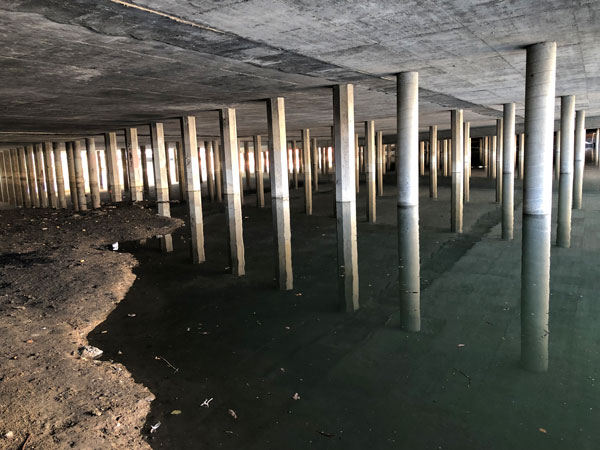
Water and sediment from Redwood Creek under Highway 101.

Solar drying ingredients to make paper pulp.
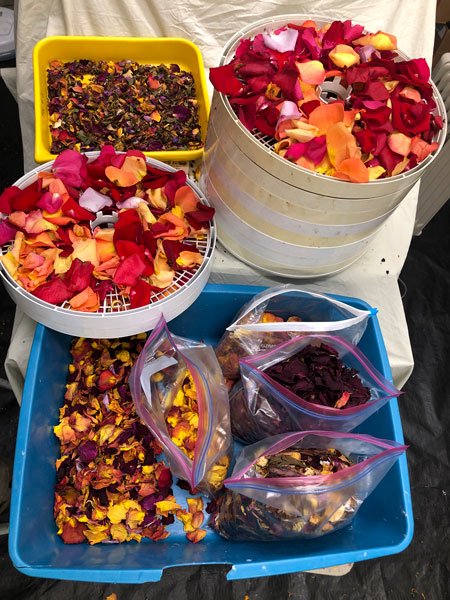
Dehydrating ingredients to make paper pulp.

Keeping track of and testing collected ingredients.

Processing materials with hammers, food processors and coffee grinders.
Making Pulp
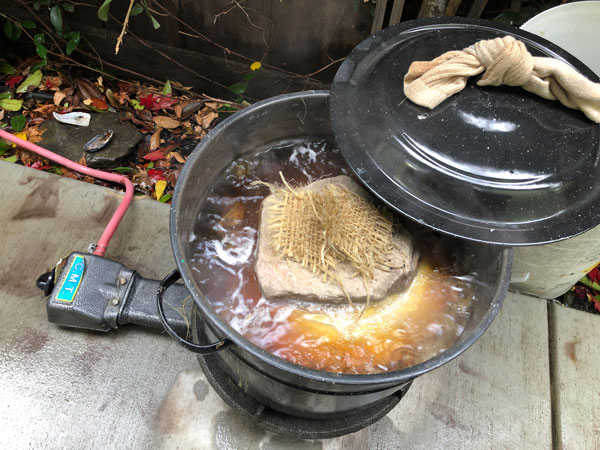
Cooking jute to isolate cellulose and soften fiber for beating.

Getting ready to put cardboard theatre props into the paper beater.
Making Paper Sheets

Sheet making station.
>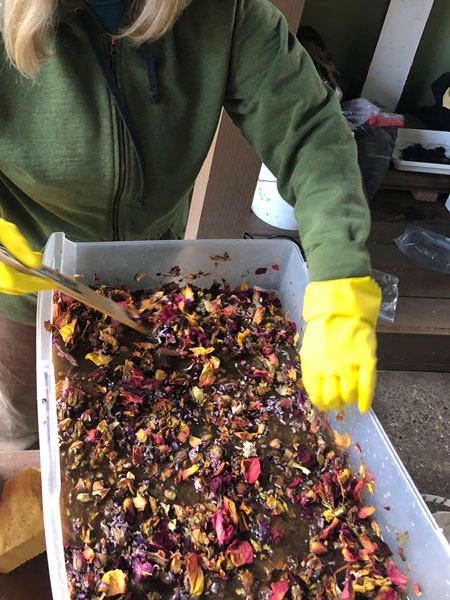
Stirring the flower pulp.
>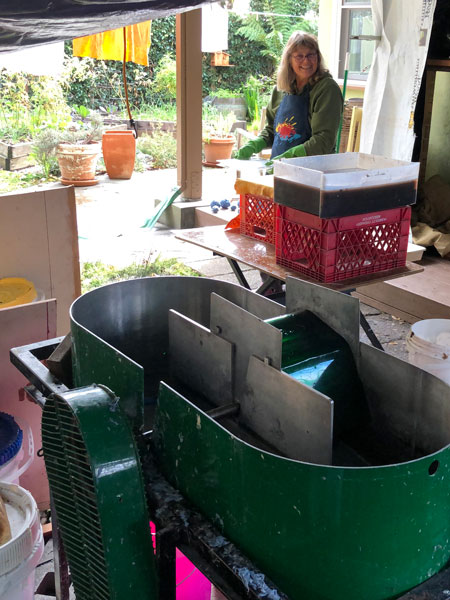
Making 9" x 12" sheets to transfer to 7' diameter tree trunk structure.

Paper mould and deckle with Redwood Creek water, sediment and oyster shells from local restaurant.
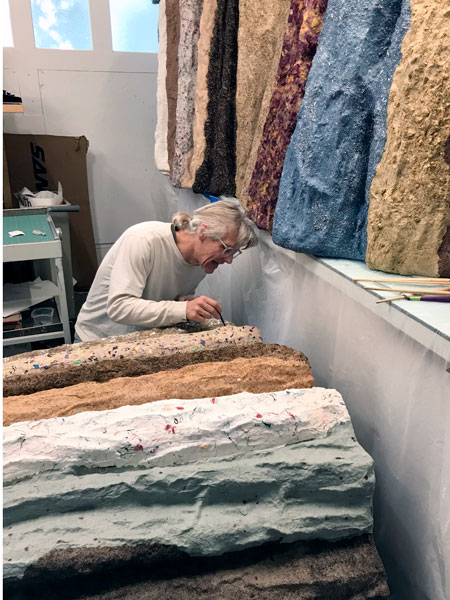
Transferring paper pulp sheets to create bark.
The Tree

You are the Tree trunk east section.
>
You are the Tree trunk south section.

You are the Tree trunk west section.
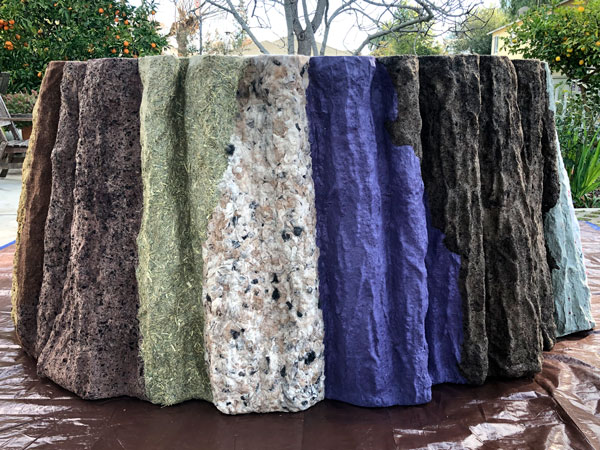
You are the Tree trunk north section.

You are the Tree trunk bark structure.
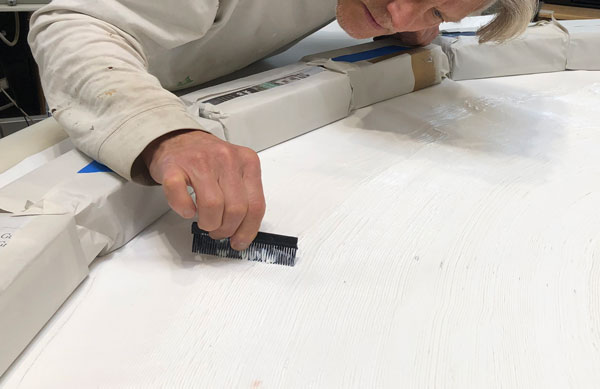
Combing acrylic media to create tree rings.

Painting the stump surface.
Photo Shoot for Interior Images
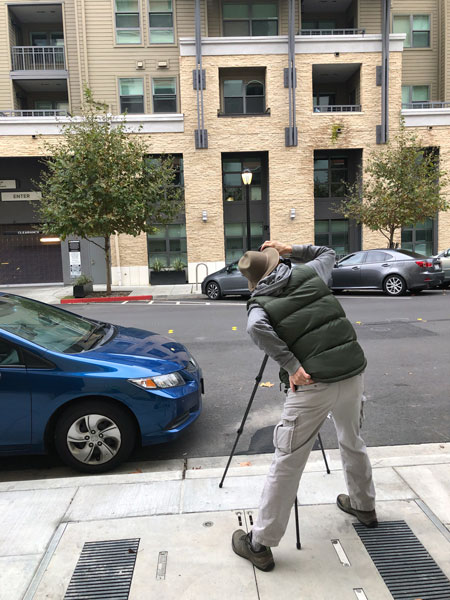
Photographer David Beres photographed the Redwood City residential towers specifically for this project.
Installation
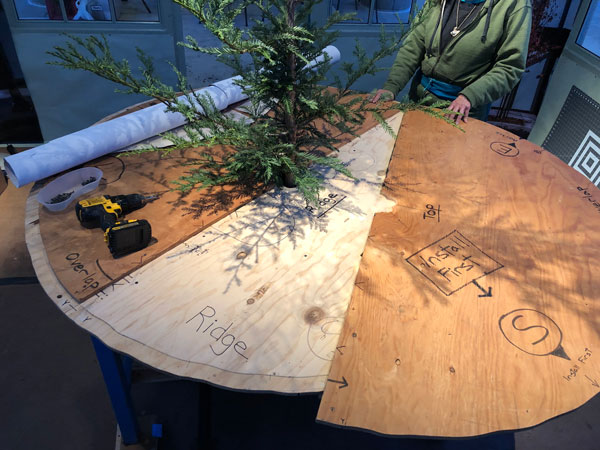
Assembly with 6' tall potted Coast Redwood tree located below trunk surface (coming out of trunk).

Assembly which will have small potted Coast Redwood tree on top of tree trunk structure.

Storing the sculptural components.

Touching Station provides visitors opportunity to touch paper samples from the 25 pulp recipes.
Artists' Bios
Kent Manske
Kent Manske creates images and symbols to inquire, process, manage, convey and assign
meaning to ideas about human existence. He uses both traditional and digital printmaking
and book publishing processes to create one-of-a-kind and limited-edition works on paper.
Manske has a BFA from the University of Wisconsin-Eau Claire and an MFA from The School
of the Art Institute of Chicago. He was Professor of Art at Foothill College from 1990-2015.
In 1992 he co-founded PreNeo Press in Redwood City, California. His work can be found in
public and private collections, including the San Francisco Fine Arts Museums and the
Oakland Museum of California. Kent's website.
Nanette Wylde
California born Nanette Wylde is an interdisciplinary artist, writer and cultural worker
making socially and environmentally reflective works in hybrid media. Wylde has a BA in
Behavioral Science from San José State University. Her MFA is in
Interactive Multimedia and Printmaking from Ohio State University. She
is Professor Emerita of Art and Art History at CSU Chico where she
taught for 21 years.
Her artist's books, prints and electronic works are included in
significant international collections. Wylde's interests include:
language, beliefs, systems, movement, reflection, history, identity, perceptions,
stories, socialization, definitions, context, memory, experience, change,
the natural world, and residue. Nanette's website.
Credits
You are the Tree was commissioned by Fung Collaborative Projects in collaboration with Redwood City Improvement Association for the Redwood City Art Kiosk in 2020.
The artists would also like to thank the Redwood City Parks and Arts Foundation and the Redwood City Arts Commission for their passionate support for art and artists.

